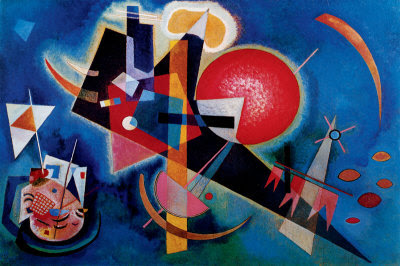It Sounds Blue! Kandinsky and the Brain
September 26, 2010
Tags:
Science
The overwhelming "what? that's going on right now too?!" of New York City has hit me for real this month, so the blog posts are sadly lacking. But, since this science journalism stuff means I am bombarded with ideas and stories to write about a day, I'm going to make an extra effort to post more often (I need at least some partial record of my thoughts during these wonderfully-crazy months).
So, for starters, I have to share this amazing series in the New Scientist called "Six ways that artists hack your brain." It's all about the neuroscience and psychology of how we perceive/understand/interpret artwork (or get really confused by it). To my surprise, this cross-disciplinary field even has its own a name: neuroaesthetics. Below is a quote from one section about synaesthetes, people who have a neurological condition where their senses seem to get mixed up — they'll hear blue or taste yellow, for example.
LETTERS, words, numbers, sounds, touch, pain and smell all trigger flashes of colour in Carol Steen's mind. The New York-based artist first discovered she could paint her synaesthetic visions after a visit to her acupuncturist. "Each time a needle went in a colour flashed in front of my eyes," she recalls. "When all the needles were in it was like watching a movie. I rushed home and realised I could recall enough to paint a part of what I had seen."Other synaesthetic artists include David Hockney and Wassily Kandinsky, who painted the piece below, entitled Blue. There is still some speculation over whether Kandinsky actually had synaesthesia or was simply influenced by reports of the phenomenon in other people. But to Christopher Tyler of the Smith-Kettlewell Brain Imaging Center in San Francisco, who has analysed Kandinsky's work, it is obvious (Journal of the History of Neuroscience, vol 12, p 223). "It's very explicit in his work and his writings. He went to a performance of Wagner's music and then wrote about how vivid the visual impressions of the horns were and the colour that the music evoked in his mind. That's synaesthesia," he says.Steen agrees: "I saw a sphere like the one in Kandinsky's Blue in one of my acupuncture sessions. Since it is really hard to explain your visions to someone, I assume Kandinsky was a synaesthete." The striking colour contrast with the red dot is also familiar to her.These experiences are probably due to extra connections between the auditory and visual cortex, says Jack Cowan, a mathematical neuroscientist at the University of Chicago. He thinks the additional flow of information into the visual cortex overloads its normal inhibitory mechanisms, allowing spontaneous waves of activity that would normally be eliminated to propagate through the brain. These signals may represent shape or colour. Since the brain can't tell whether a signal was generated within the brain or externally, synaesthetes see the shapes as if they came from the eye.
Check out the other parts of the series like the emotional response to impressionism or Dali's illusions. More to come soon!
